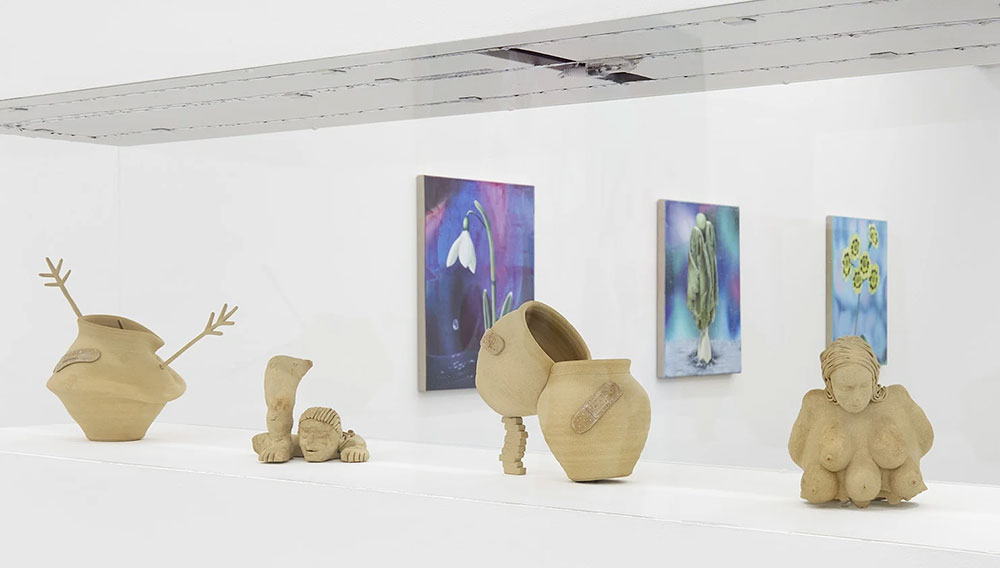
A Little History: Jane Hayes Greenwood, installation view, Castor Gallery, London, 23 June – 29 July 2023.
Castor Gallery, London
23 June – 29 July 2023
by JILLIAN KNIPE
Parenthood, and particularly motherhood, is all the rage. Sparks fly with passionate demands to include artist mothers, to insist on a woman’s right to her own body, to declare the realities of milk industrialisation and lactation histories, to protest with “fuck the cis-tem” banners, in an effort to rightly place trans parents on the map of parental devotion.It is as if the world has suddenly awoken to the complicated configurations of parenting. And equally to the fact that women’s brains and bodies can function at full charge, despite their seeping breasts or limb-clawing toddler attachments. Jane Hayes Greenwood’s A Little History throws its teething ring into the mix of hot debate and challenging assumptions, by presenting a broad definition of figurative paintings and sculptural works that portray her personal take on the circular motion of birth, death and mothering.
While Hayes Greenwood’s metaphorical flora and fauna figures continue, her work has developed a more direct and personal take on expressing how lives and loves are lived and lost, through human-like women. Plus, a lot of pots – although these are critically nowhere near the neoclassical vessel of life held by a wanton, pubescent girl in The Source/La Fuente (1820-1856) painted by Ingres, a man then aged 76. Rather than passive props to delight the menfolk, in the paintings of A Little History, both pot and its female carrier are of one, heavily weighted body, curiously edging towards 3D software renderings or poised fixtures of pliable rubber.
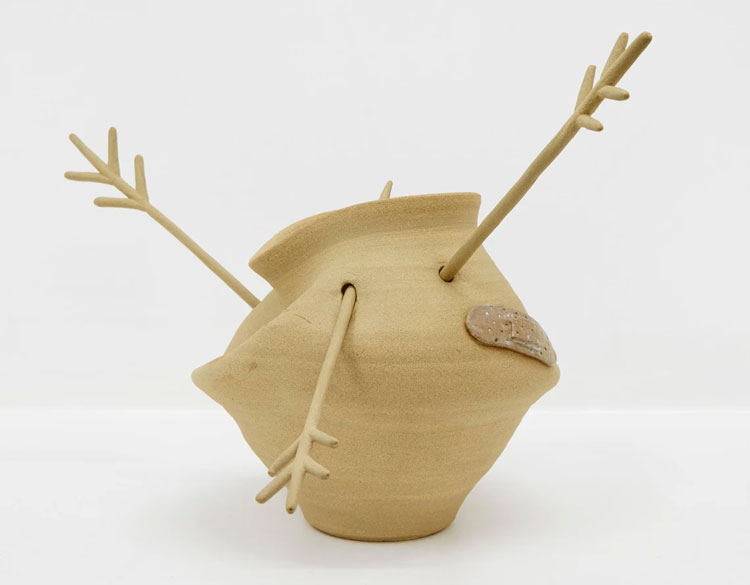
Jane Hayes Greenwood. A Little History (1), 2023. Stonewear, 28 x 30 x 22 cm approx.
Of note is how Hayes Greenward’s characters are not confronting the viewer. Neither do they hold the renaissance gaze of a downward glance, proving their piety. Instead, all identities are sealed within their closed eyelids. They are oblivious to the viewer who, in a real-life context, is probably oblivious to them. And because we are not distracted by who they are, our attention is invested in the states of being that their bodies suggest and how that might be a subset of society’s ambivalence towards the relentlessly exhausting efforts of motherhood.
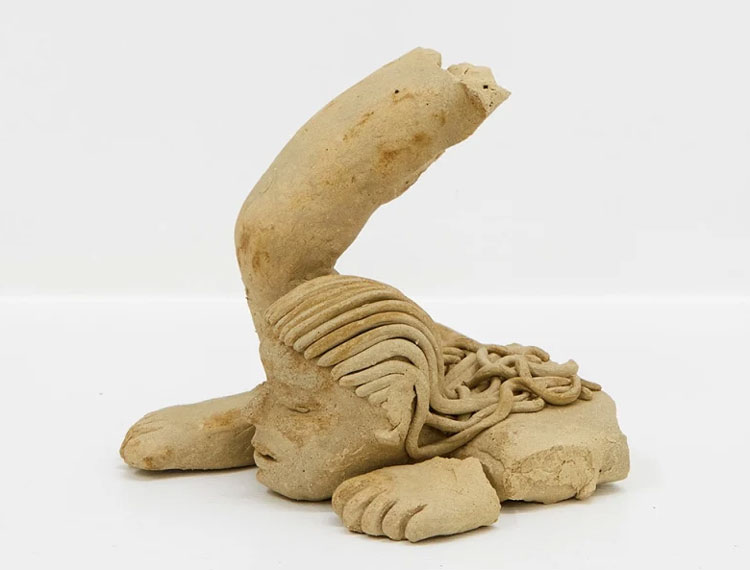
Jane Hayes Greenwood. A Little History (2), 2023. Stonewear, 12 x 14 x 14 cm approx.
A cabinet of small, stoneware sculptures sits at the threshold of the main display area. It acts as a foretelling on arrival and an underscore on departure, of the more fragile aspects of the work. Ranging from precariously balanced vessels, plastered and speared with arrows, to a multi-breasted torso and dismembered limbs, each is titled A Little History, and all are sized to hold in the hand, like intimate, personal carvings. They seem to question the “Venus” reference and romance attributed to prehistoric fertility figurines, while the unadorned simplicity of the pierced pots, points to the ordinariness of pain and suffering.
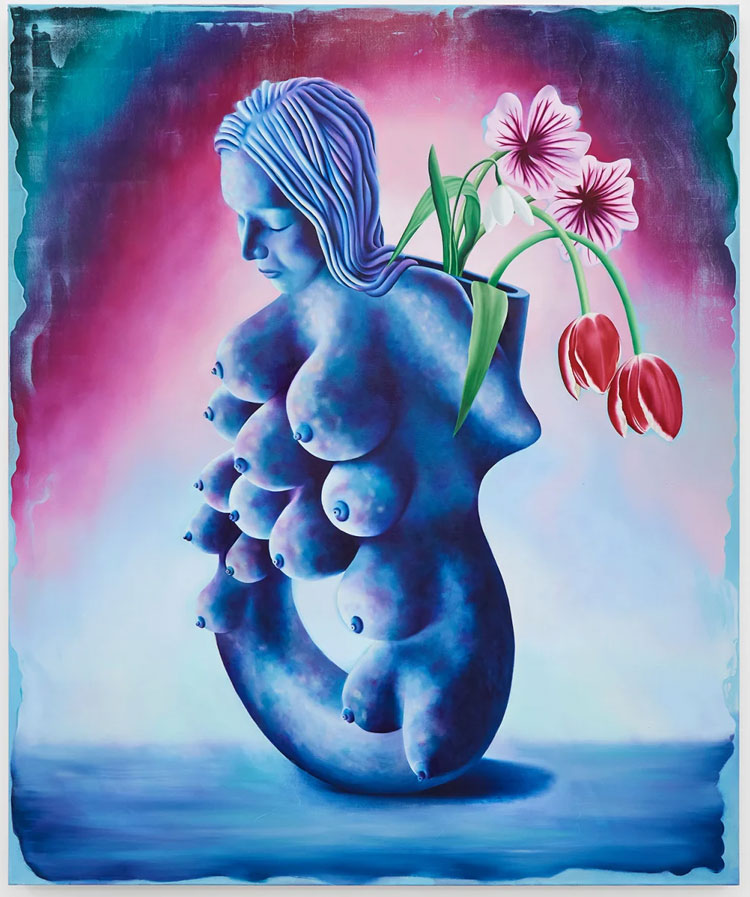
Jane Hayes Greenwood. The Land of Plenty, 2023. Oil on linen, 180 x 150 cm.
Placed diagonally, The Land of Plenty (2023) depicts a multi-breasted pacifier-mother with protruding nipples, while Petrified (2023) is covered with what appear to be inverted thumb dents, like dead matter that has been prodded with curiosity.
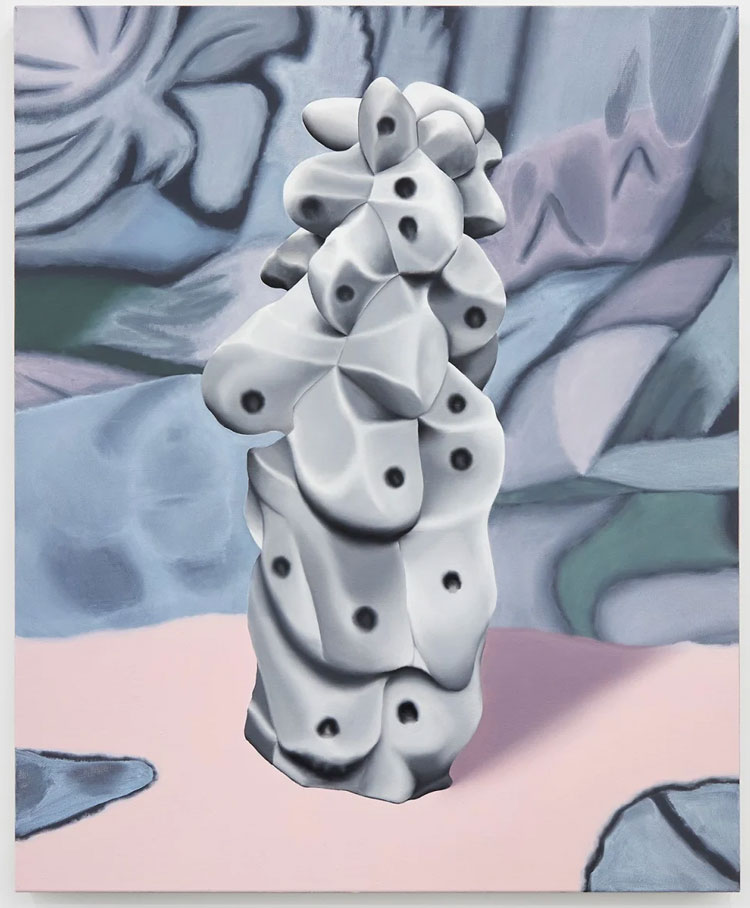
Jane Hayes Greenwood. Petrified, 2022. Oil on linen, 110 x 90 cm. Copyright the Artist.
These paintings remind us of the double edge where there are no endings without beginnings and, likewise, no beginnings without ends. They bookend the life and death scenario, as the remaining works narrate the critical moments in between. They do this in a range of strange suggested contexts, which hover between reality and its opposite: weightlessly floating or bench-topped in software spaces, else papery images, revealed as billboard layers are stripped away.
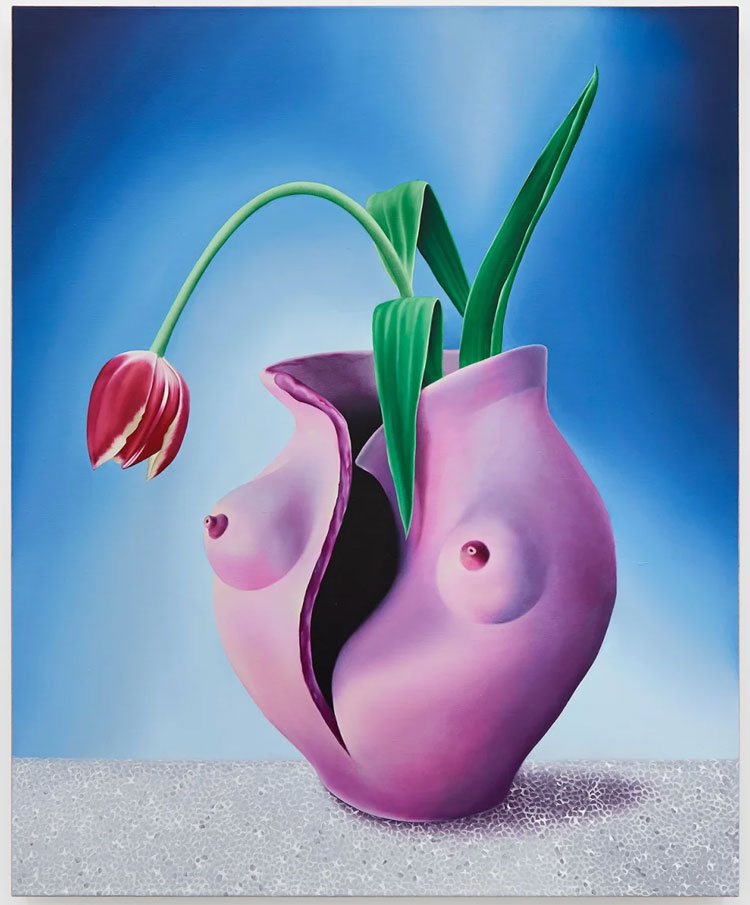
Jane Hayes Greenwood. Raw Material, 2023. Oil on linen, 110 x 90 cm.
Almost in response to The Source/La Fuente, Hayes Greenwood’s Raw Material (2023) presents itself as a plant pot split at the front with a breast on either side. It is punchy in pulsating magenta like the torso of a temptress, breasts alert with desire, although these are so far apart from one another that they might equally be eyes, with the leafy overhang mimicking the sultry pose of a flyaway fringe. So, the painting shares a cheeky joke about looking and being looked at, confusing us about who is in control of the scene.
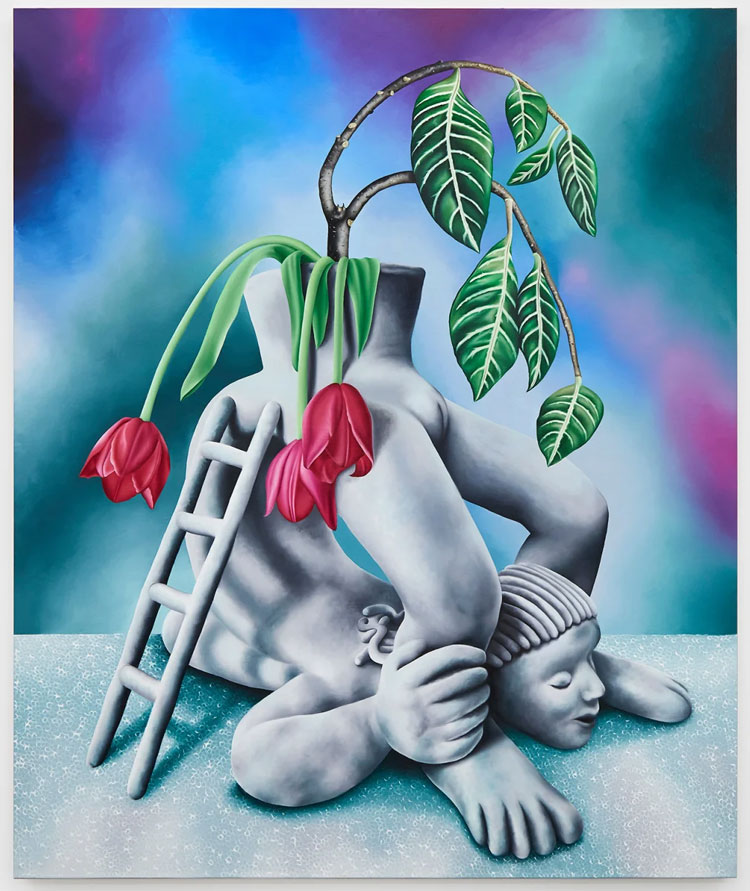
Jane Hayes Greenwood. The Contortionist, 2023. Oil on linen, 180 x 150 cm.
If Raw Material kicks off the procreation process, then The Contortionist (2023) depicts the complicated result. Instead of the bendy beauty of Kate Moss in Marc Quinn’s barely palatable Sphinx (2006), here we see a character ensuring access to the nurturing she provides, while pushing the boundaries of flexibility. In another take on control, and in spite of the huge effort, she looks quite self-sufficient, as if to contest, that, yes, this motherhood gig is difficult but also definitely doable.
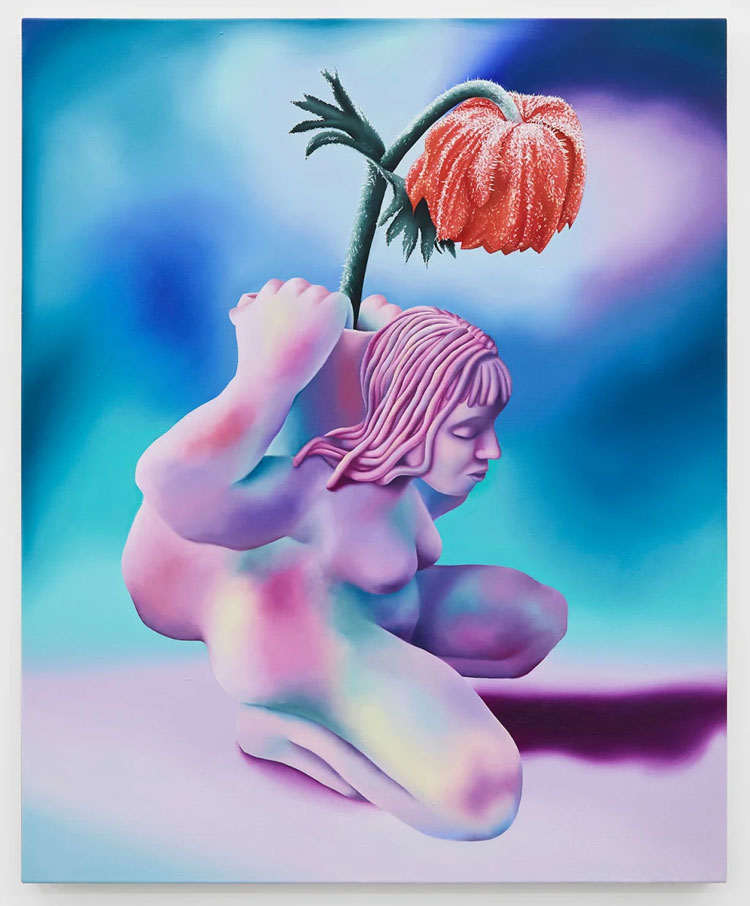
Jane Hayes Greenwood. The Violet Hour, 2023. Oil on linen, 110 x 90 cm.
In sympathy and contrast, The Violet Hour (2023) shows a weary carrier of an embodied pot on her back. Her red flower droops despite the promise of its sparkly petals. Her chunky body casts a shadow on an unclear ground, suggesting this place is a state of mind. She is perhaps slightly bruised, dappled in soft patches of pink, green and purple, during the slog of the repeated bedtime ritual, carrying a tired little angel to their room, while the question of where women get their strength is proposed and answered by Samuel Beckett’s call – “I can’t go on. I’ll go on.”
A Little History may be slim in the context of the whole world and its myriad of fragmented stories of the past, but it suggests a bigger, broader future. Through its glimpses into personal loss and gain, nurturing and pain, Hayes Greenwood strikes against the saintly and sexy imagery of fecundity and invites us into a world of tenderness and tiring continuity. There seems to be an insistence that bodies will be lumpy and awkward in contrast to, and in conjunction with, the new idealism that is located in the digital. Her plasticine-like figures appear endlessly malleable though it is important to remember that the material itself is liable to dry out and crack without regular watering. So, by making the case for her reality of parenthood, Hayes Greenwood contributes to and, therefore, contributes to opening up, the buzzing dialogue about a string of possible family formulations that might shape generations to come, though heed, that they themselves need our support.